
‘This represents a combination of 12 moves beginning with 13 b4!, a very rare instance in modern chess of a master having to calculate so far ahead.’
Edward Winter
In his annotations to the game Capablanca v Czerniak, Buenos Aires Olympiad, 1939, Alekhine gave a variation leading to 24 Qd8 mate and commented:
‘This represents a combination of 12 moves beginning with 13 b4!, a very rare instance in modern chess of a master having to calculate so far ahead.’
Source: Gran Ajedrez by A. Alekhine (Madrid, 1947), page 137.
(1995)

F.J. Lee-Em. Lasker, London, 4 July 1899
Play continued: 37...Rxd4 38 cxd4 Qg4+ 39 Kf1 Qg2+ 40 Ke1 Qg1+ 41 Kd2 c3+ 42 Qxc3 Qxf2+ 43 Kd1 e3 44 Bb3+ Kg7 45 d5+ Kh6 46 Qe1 Bc8 47 White resigns. After the game Lasker stated that he had seen 46...Bc8 at move 37 (Wiener Schachzeitung, October 1899, page 163). The magazine gives as an alternative line 46...e2+ 47 Kd2 Qd4+ 48 Kc2 Qe4+ 49 Kc3 Qe3+ 50 Kc2 Ng2, and also reports that from the diagram Tarrasch offered another possibility: 37...Qg4+ 38 Kf1 Qg2+ 39 Ke1 Qg1+ 40 Kd2 Ng2 41 Qe2 e3+ 42 fxe3 Bf3.
(2140)
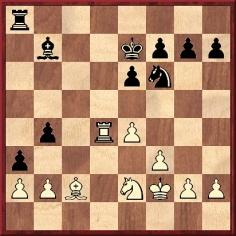
In the game between Burn and Showalter in the 1898 cable match between Great Britain and the United States the above position arose after White’s 29th move. The US master now played 29...b3 30 Bxb3 axb2 31 Rdl Nxe4+ 32 fxe4 Bxe4 33 Nc3 Bg6 34 Nb1 Rc8 35 Ke3 Rc1 36 Na3 Rxd1 37 Bxd1 b1(Q) 38 Nxb1 Bxb1 39 a4 Kd6 40 a5 Kc5 41 Be2 Bc2 42 h4 Ba4 43 a6 Kb6 44 g4 Bd7 45 Ke4 Bc8 and Black won after move 58.
Page 578 of the March 1898 American Chess Magazine declared regarding 29...b3: ‘A remarkable continuation, and one in which Showalter says he counted 11 moves through a sacrifice and recovery’. On page 157 of the April 1898 BCM James Mason called the ending ‘remarkable and instructive’.
Annotating his move 31 Nd6 against Sir George Thomas at Carlsbad, 1923, Alekhine wrote in his first Best Games collection:
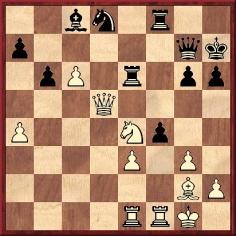
‘The winning move, of which the consequences, in the leading variation, had to be analysed 12 and 15 moves ahead.’
Page 55 of Alexei Shirov’s Fire on Board (London, 1997), a five-star book, reports a case which occurred in this position:
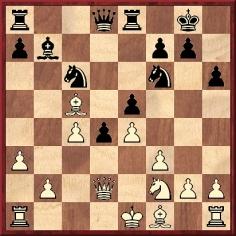
A. Hauchard-A. Shirov, World Junior Championship, Santiago, 1990
Play went 16...Qc7 17 b4 Nd8 18 Nd3 Ne6 19 Be2 Bxe4 20 fxe4 Nxe4 21 Qc2 N4xc5 22 Nxc5 Nxc5 23 bxc5 e4 24 O-O Rad8 25 Rad1 Qxc5 26 Kh1 d3 27 Bxd3 exd3 28 Qc3. Instead, 28 Rxd3 would lose outright to 28...Qf5.
Shirov’s note at move 16 reads: ‘It is surprising that, when making this move, I had already seen the possibility of a queen sacrifice on move 28.’
(2167)
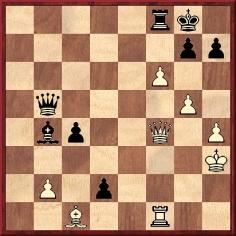
In his first Best Games volume Alekhine used the phrase ‘the longest which I have ever undertaken’ to describe the combination beginning with 33…Qd7+ in his game against Treybal at Pistyan, 1922, claiming that the winning manśuvre comprised no fewer than 20 moves.
On page 32 of Combination in Chess by G. Négyesy and J. Hegyi (Budapest, 1970) this position was given:
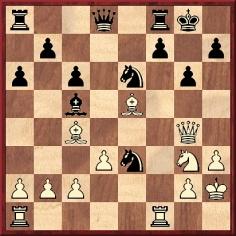
R. Charousek v Engländer (Kassa/Košice, 1894)
White played 19 Qxe6 and the book commented:‘One of the longest combinations of all times, this 15-move combination was played by Rezső Charousek, the Hungarian chess genius who died in his prime.’
On page 174 of The Golden Dozen (Oxford, 1976) Irving Chernev wrote regarding Botvinnik v Chekhover, Moscow, 1935:
‘The longest combination ever seen in master play is this 22-mover by Botvinnik.’
Latest update: 23 March 2025.
To the Chess Notes main page.
To the Archives for other feature articles.
Copyright: Edward Winter. All rights reserved.